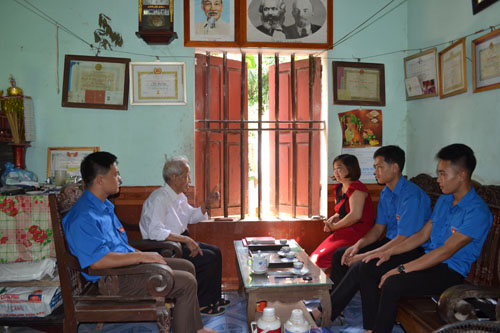



Bui Van Thong recounts the time when he met Uncle Ho
for Party members and young people of Kim Truy commune, Kim Boi district.
"Uncle Ho visited the district Party Committee’s
office at 9am, on September 19, 1964. He
took a tour of the kitchen, canteen, water well, and bathroom. He asked local
authorities to build high wall around the well and make a cover to prevent
children from falling into. The kitchen should be kept clean. He gave candies
to children at the nursery house and sang with them.
After listening to a report delivered by the Secretary of the district Party Committee, Uncle Ho suggested conducting intensive farming and planting industrial crops in order to raise food productivity and minimise fallow lands. He also urged all local people to study to enhance their academic standards and recommended the local authorities to better their management,” Thong narrated.
For Thong, meeting Uncle Ho is the most unforgettable memory in his life. He wrote the memories down for younger generations, yet he keeps them in his mind.
"I was working as head of the planning and statistics division when I met Uncle Ho. I could feel that Unclo Ho just took a quick look and gave clear instructions. He said the dish cabinet and bike parts should be called in Vietnamese, in stead of borrowed words. Although a great leader, he looked simple in brown clothes, rubber sandals. When being invited to take a nap on a big beautiful wooden bed, he refused and used a normal one and called on the authorities to spend less,” Thong said.
Later when Thong served as Vice Chairman of the district Administrative Committee, he and other local authorities followed Uncle Ho’s teachings in daily management in all fields.
Thong has collected and kept in his note book nearly 100 photos of Uncle Ho he cut from newspapers. He also wrote down his feelings on the late President below each photo.
The feelings on Uncle Ho are commonly shared among all the people in Kim Boi district, including youths. Bui Van Huan, Secretary of the Kim Truy commune chapter of the Ho Chi Minh Communist Youths Union (HCMCYU) , and Nguyen Hong Dieu, a communal official, listened with concentration to Thong’s narrative. The admiration and love for the late President give impetus for the local HCMCYU chapter to continue implementing the programme "the youths follow Uncle Ho’s teachings”.
The Kim Boi youth has launched numerous programmes in May. They include a contest on revolutionary songs, seminars, and talks with such speakers as Thong, who inspires residents in Muong Dong to follow Uncle Ho’s teachings and lifestyle, according to Huan, who is also Secretary of the HCMCYU’s Kim Boi district chapter.
Following Uncle Ho’s teachings, all authorities and residents in the district made efforts to overcome hardship, promote production, contributing to the southern liberation and the nation’s reunification. Concrete tasks were set to develop the district in all fields. When Uncle President visited the locality, the Kim Boi district Party organisation was set up for five years with few members. Many communes had no party members. To date, there are 59 party organisations, 364 party cells and 6,077 party members.
Attention has been paid to building strong party organisations with focus on studying and following President Ho Chi Minh’s thought, ethics and lifestyle. The Kim Boi district Party Committee continues boosting implementation of the Politburo’s Directive No 5.
Nguyen Manh Cuong, Secretary of the Kim Boi district Party Committee, outlined the local achievements, such as upgraded infrastructure; progress in social and cultural fields, maintenance of national defence – security; stable social order, care for social welfare beneficiaries, the poor and the disadvantaged households.
The local material and spiritual life has been improved, while per capita
income reached 16.5 million VND (in 2016), Cuong said, adding all children go
to school at at the school age, and the rate of doctor per 10,000 people is
4.6.
Besides, local farmers have conducted intensive farming models, such as growing segment fruit trees in the communes of Kim Son, Nam Thuong, My Hoa, Sao Bay, Bac Son, Du Sang, Binh Son, and Vinh Tien; mushroom growing in My Hoa commune; longan trees in Son Thuy commune; and asparagus in Nam Thuong commune./.